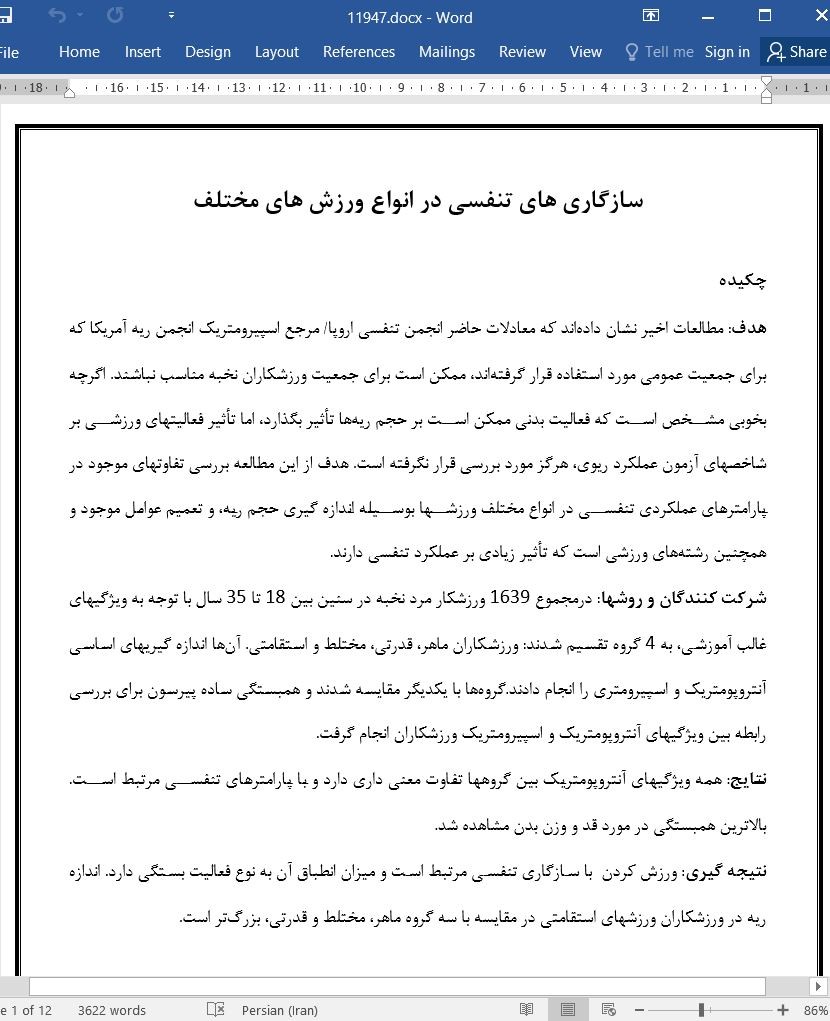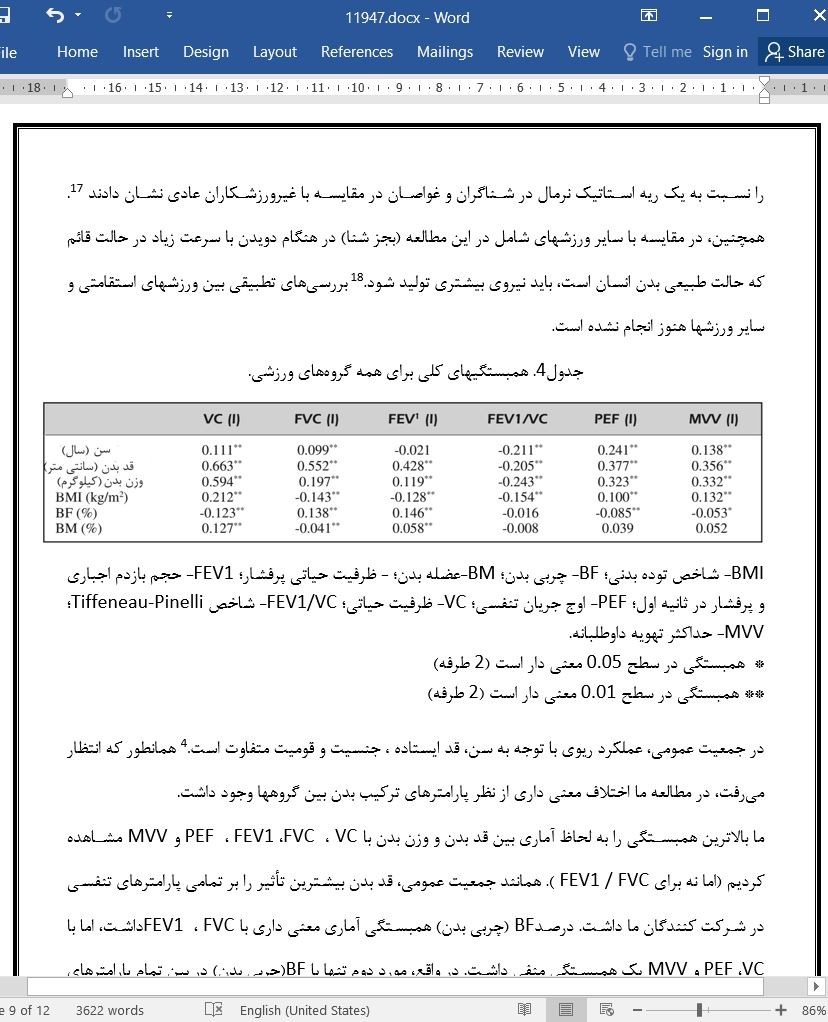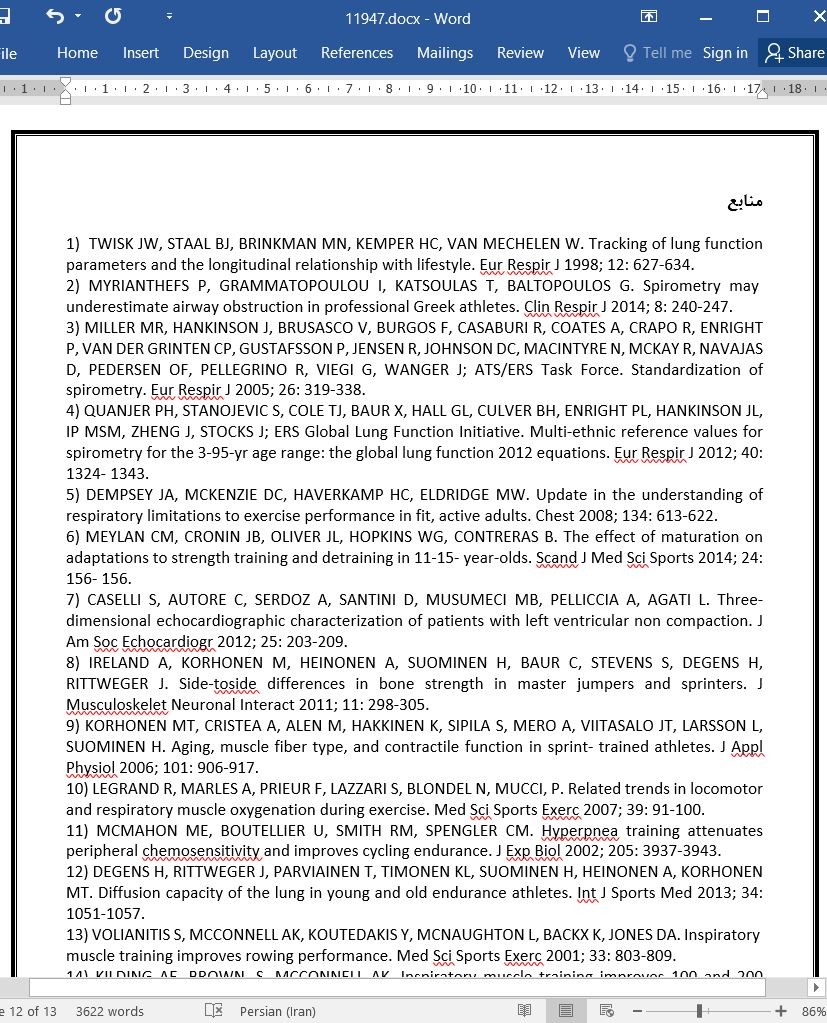
سازگاری های تنفسی در انواع ورزش های مختلف
چکیده
هدف: مطالعات اخیر نشان دادهاند كه معادلات حاضر انجمن تنفسی اروپا/ مرجع اسپیرومتریک انجمن ريه آمريكا که برای جمعیت عمومی مورد استفاده قرار گرفتهاند، ممکن است برای جمعیت ورزشکاران نخبه مناسب نباشند. اگرچه بخوبی مشخص است که فعالیت بدنی ممکن است بر حجم ریهها تأثیر بگذارد، اما تأثیر فعالیتهای ورزشی بر شاخصهای آزمون عملکرد ریوی، هرگز مورد بررسی قرار نگرفته است. هدف از این مطالعه بررسی تفاوتهای موجود در پارامترهای عملکردی تنفسی در انواع مختلف ورزشها بوسیله اندازه گیری حجم ریه، و تعمیم عوامل موجود و همچنین رشتههای ورزشی است که تأثیر زیادی بر عملکرد تنفسی دارند.
شرکت کنندگان و روشها: درمجموع 1639 ورزشکار مرد نخبه در سنین بین 18 تا 35 سال با توجه به ویژگیهای غالب آموزشی، به 4 گروه تقسیم شدند: ورزشکاران ماهر، قدرتی، مختلط و استقامتی. آنها اندازه گیریهای اساسی آنتروپومتریک و اسپیرومتری را انجام دادند.گروهها با یکدیگر مقایسه شدند و همبستگی ساده پیرسون برای بررسی رابطه بین ویژگیهای آنتروپومتریک و اسپیرومتریک ورزشکاران انجام گرفت.
نتایج: همه ویژگیهای آنتروپومتریک بین گروهها تفاوت معنی داری دارد و با پارامترهای تنفسی مرتبط است. بالاترین همبستگی در مورد قد و وزن بدن مشاهده شد.
نتیجه گیری: ورزش کردن با سازگاری تنفسی مرتبط است و میزان انطباق آن به نوع فعالیت بستگی دارد. اندازه ریه در ورزشکاران ورزشهای استقامتی در مقایسه با سه گروه ماهر، مختلط و قدرتی، بزرگتر است.
چشم اندازهای مطالعه: این مطالعه بر روی نمونه بزرگی از ورزشکاران که در انواع مختلف ورزشها فعالیت داشتند انجام شد. این واقعیت که خستگی عضلات دمی در طی انجام فعالیتهای ورزشی رخ میدهد، چالش دیگری را برای بررسی نقش بالقوه تمرینات عضلات تنفسی به عنوان روشی برای تقویت عملکرد بدنی فراهم میآورد. درک الگوهای واضح ورزشها که بیشترین دستاورد یا مؤثرترین پروتکل آموزشی تمرینات عضلات دمی / عضلات تنفسی را نشان میدهند، کار دشوارتری است. پاروزنی و قایق رانی، شنا، دوی مسافت طولانی و ماراتن ، دوچرخه سواری ، ورزشهای سه گانه (شامل شنا و دوچرخه سواری و دو ) و ورزشهای پنجگانه (شامل پرش طول و پرتاب نیزه و دو 200 متر و پرتاب دیسک و دو 1500 متر) ورزشهایی هستند که بیشترین اثر بهبودی را در سیستم تنفسی دارند.
Abstract
OBJECTIVE: Recent studies demonstrated that current European Respiratory Society/American Thoracic Society spirometric reference equations, used in general population, may not be applicable in population of elite athletes. Althought it is well known that physical activity may affect lung volumes, the effect of sporting activity on pulmonary function testing indices was never examined. The aim of this study was to examine the differences in functional respiratory parameters in various types of sports by measuring lung volumes and to extend the existing factors as well as sport disciplines which affect respiratory function the most.
SUBJECTS AND METHODS: A total of 1639 elite male athletes, aged 18-35 years were divided in 4 groups according to the predominant characteristics of training: skill, power, mixed and endurance athletes. They performed basic anthropometric measurements and spirometry. Groups were compared, and Pearson’s simple correlation was performed to test the relation between anthropometric and spirometric characteristics of athletes.
RESULTS: All anthropometric characteristics significantly differed among groups and correlate with respiratory parameters. The highest correlation was found for body height and weight.
CONCLUSIONS: Sports participation is associated with respiratory adaptation, and the extent of adaptation depends on type of activity. Endurance sports athletes have higher lung volumes in comparison with skill, mixed and power group of sport.
Study perspectives: The study was conducted on a large sample size of athletes who perform wide range of different type of sport. The fact that inspiratory muscle fatigue occurs during sport activity provides further challenge to investigate the potential role of respiratory muscles training as a method to enhance physical performance. Clear patterns of the sport that shows the most obtains or the most efficacious training protocol of inspiratory/respiratory muscle training are more difficult to perceive. Rowing and canoeing, swimming, long-distance running and marathon, cycling, triathlon and pentathlon are the sports which improve respiratory system the most.
چکیده
مقدمه
شرکت کنندگان و روشها
شرکت کنندگان
روشها
تحلیل آماری
نتایج
بحث
نتیجه گیری
تعارض منافع
منابع
Abstract
Introduction
Subjects and Methods
Subjects
Methods
Statistical Analysis
Results
Discussion
Conclusions
References
- اصل مقاله انگلیسی با فرمت ورد (word) با قابلیت ویرایش
- ترجمه فارسی مقاله با فرمت ورد (word) با قابلیت ویرایش، بدون آرم سایت ای ترجمه
- ترجمه فارسی مقاله با فرمت pdf، بدون آرم سایت ای ترجمه



